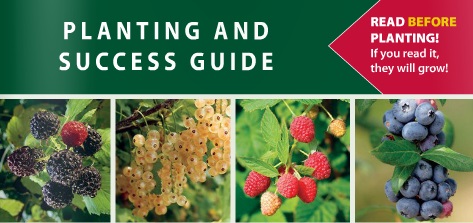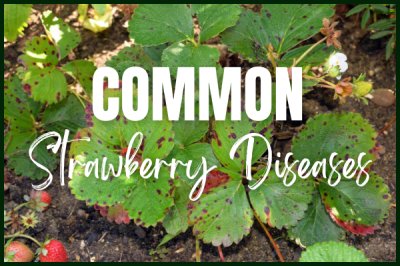WHAT IS A PATHOGEN?
A pathogen is an organism causing disease to its host. Bacteria, viruses, nematodes, and fungi are pathogens that can cause plant diseases. Pathogens enter their host and seize the plant’s energy for their use. Pathogens can enter a plant in various ways, including wounds or natural openings, penetrating plant tissue, mechanical damage, or insect transmission.
WHAT IS A DISEASE CYCLE?
A disease cycle is a series of events involved in disease development. In most disease cycles, the basic steps are inoculum production, the spread of inoculum to a susceptible host, penetration of inoculum into a host, infection, secondary cycles, and pathogen survival between host plants.
WHY IS IDENTIFICATION VITAL?
Identifying pathogens is the first step in controlling plant diseases and producing quality crops. Proper identification is necessary to implement effective management strategies.
COMMON STRAWBERRY DISEASES
Red Stele
Red Stele is a root and crown rot caused by the soil-inhabiting fungus Phytophthora fragariae.
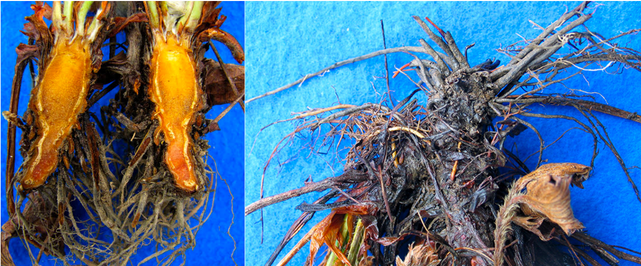
Photos courtesy of Margaret McGrath, Cornell University
Symptoms
Symptoms are more apparent in spring on established plantings, and infections typically occur in patches where the soil remains the wettest. Older leaves will turn yellow, orange, or red, while younger leaves will turn bluish-green. Infected plants have stunted growth, and as the disease roots progress, plant size, yield, and berry size will decrease. The fungus will cause lateral roots to die, and the main roots will have a “rattail” appearance. Infected plants eventually wilt and die.
Disease Cycle
Favors areas with cool, moist soil conditions, notably heavier clay-like soils. Diseased roots spread spores that can infect healthy roots. Spores travel through the soil solution and infiltrate the tips of the roots in the root system. The roots will begin to rot a few days after infection. As the disease progresses, the fungus will produce more spores that will become incorporated into the soil.
Powdery Mildew
The fungus Sphaerotheca macularis causes powdery mildew.
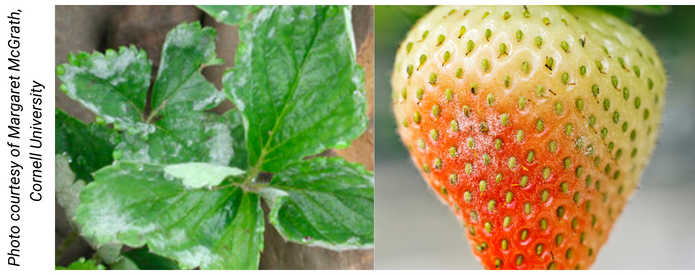
Photo courtesy of Margaret McGrath, Cornell University
Symptoms
Powdery mildew is primarily perceived as a foliage disease but may also affect flowers and fruit at all stages of development. The first symptom of leaf infection is small, white, powdery colonies on the underside of leaves. As these colonies enlarge, they will cover the entire underside of the leaves and cause the edges of the leaves to curl. Purple-reddish blotches will become visible on the upper and lower leaf surfaces as the disease progresses. Infected flowers produce deformed fruit or no fruit at all. The disease causes immature fruits to harden and dry out, while mature fruits will become seedy and have powdery and white spores.
Disease Cycle
This disease favors high humidity and warm temperatures. The fungus responsible for powdery mildew requires a living host for its survival. It may overwinter on old, living leaves.
Anthracnose
Several species of Colletotrichum can cause lesions on petioles and runners, fruit rot, crown rot, and leaf spot.
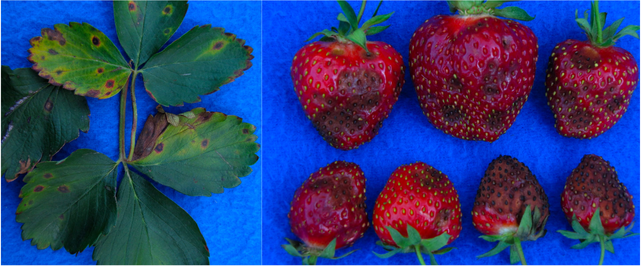
Photos courtesy of Margaret McGrath, Cornell University
Symptoms
Anthracnose can infect the petiole, runners, fruits, and flower buds. Symptoms include light-brown spots on fruit that turn dark brown or black and then enlarge. These lesions are lens-shaped and sunken. Leaf spots will form at the margins of the leaves. If flowers and flower buds become infected, they will look dried out. Lesions on the petioles and runners will develop as red streaks that later lengthen and become sunken and dark. Plants may experience stunted growth, yellowing of the leaves, wilting, and collapse of plants. When crown tissue is infected, the tissue will become brownish-red in color and decay.
Disease Cycle
Anthracnose thrives in rainy, warm harvest seasons. This disease primarily spreads by splashing water. This fungus overwinters in infected plants and plant debris. Plant tissue is required for the fungus to survive, and the fungus will not remain in the soil for long periods.
Common Leaf Spot (Birds-Eye Leaf Spot)
The fungus Mycosphaerella fragariae causes common leaf spot.
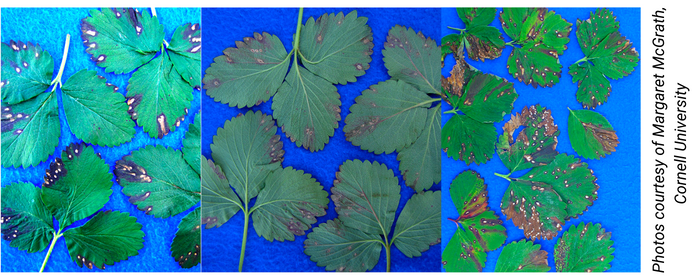
Photos courtesy of Margaret McGrath, Cornell University
Symptoms
Infected plants will have small, round, red, and purple spots that develop on the leaves and then progress into spots with lighter centers (tan, gray, or white) with a reddish-purple border. The center may fall out, leaving holes with reddish-purple borders. Spots are most apparent on the leaves but are sometimes present on runners, berry caps, leaf petioles, and berries.
Disease Cycle
This disease can occur any time during the year except during dry, hot weather. This disease can survive the winter on dead strawberry plant parts and spread to new foliage by rain or watering.
Phomopsis Leaf Blight
The fungus Phomopsis obscurans causes Phomopsis leaf blight.
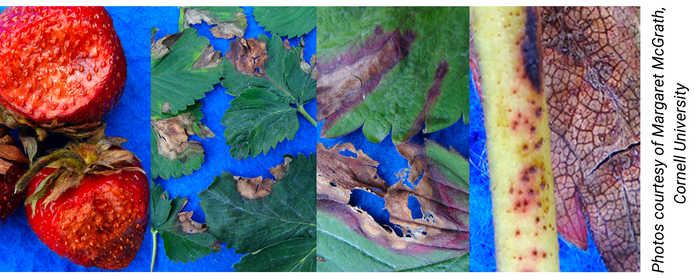
Photos courtesy of Margaret McGrath, Cornell University
Symptoms
The first symptoms are small brown spots encircled by a purple halo. As the disease progresses, spots develop into V-shaped lesions with a dark brown edge and light brown center. The wide portion of the V is near the edge of the leaf. Brown spots may develop on runner stolons, fruit trusses, and petioles and impact growth. When fruit caps become infected, fruit and caps will turn brown, causing phomopsis soft rot.
Disease Cycle
This fungus favors long wet periods, and the temperature has little effect on disease development. The fungus overwinters on older, infected leaves. Early-season rain or irrigation will spread the fungus’s spores. Leaves are infected early in the growing season, but symptoms may not form until later in the season.
Leaf Scorch
The fungus Diplocarpon earlianum causes leaf scorch.
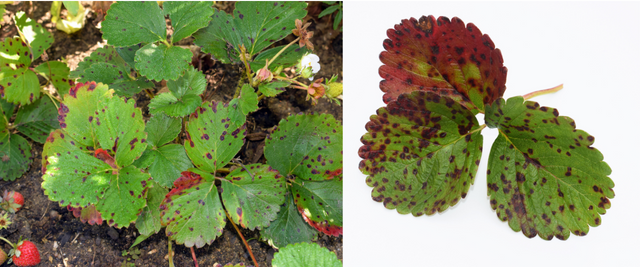
Symptoms
Irregular dark purple-red spots will appear on the upper leaf surface. Spots will gradually increase in size and may merge to dominate large portions of the leaves. Dead leaf tissue may dry and turn brown. Spots develop on the petioles and caps. Severe cases of leaf scorch may lead to stunted growth due to foliage reduction, decreased plant vigor, and lower yields.
Disease Cycle
This fungus favors long periods of rain and leaf wetness. The fungus can develop under a wide range of temperatures, but extremely hot or cold temperatures may slow its development. The fungus can survive on living and dead plant tissues but is typically worse in older plantings.
Angular leaf spot
The bacteria species Xanthomonas fragariae causes angular leaf spot.
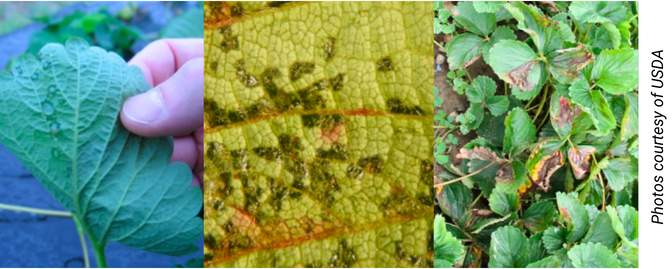
Photos courtesy of USDA
Symptoms
Symptoms appear as water-soaked spots on the lower leaf surface of older leaves, between small veins of the leaf. The lesions will appear translucent, creating a visible window-pane effect when leaves are held to the light. As the disease progresses, the lesions will expand into an angular shape and become necrotic.
The fruit cap may turn brown or black, while the berry appears normal otherwise. Under moist conditions, the bacterium will secrete a substance that, when dry, appears as a white, scaly film. The pathogen infects the foliage and fruit, and invades the plant’s vascular system, causing a general decline.
Disease Cycle
This disease develops in prolonged cold and wet conditions and favors temperatures just above freezing. This bacterium overwinters in infected plants and dead leaves. The exudate from infected leaves can spread to uninfected plants by water. Young tissue is easily infected.
Botrytis
The fungal pathogen Botrytis cinerea causes gray mold.
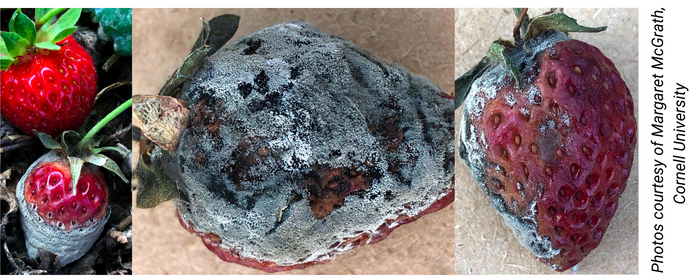
Photos courtesy of Margaret McGrath, Cornell University
Symptoms
In dry conditions, a gray, fuzzy, web-like coating develops on the fruit. When the berry is in contact with the soil, other rotten fruit, or damp surfaces, rot may appear and destroy the berry within 48 hours. Gray mold may be present during all development stages of strawberry fruit production. Gray mold can live in the green tissue but be dormant. Light brown lesions will develop on the stem, sides of the fruit, or flower petals. On undeveloped fruit, the fruit may be deformed and die before maturation.
Disease Cycle
Fruit rot starts with a blossom infection that ultimately occupies the developing fruits, causing them to rot. As the disease progresses, spores are produced and are blown or splashed onto healthy foliage. Once the fungus is established, it can continuously produce spores throughout the growing season.
The disease is most severe during bloom and harvest in seasons with long periods of rain complemented by cool temperatures and high humidity. The Botrytis cinerea fungus overwinters on old leaves and plant debris. Dead plants and fallen leaves should be removed and burned or buried.
REMINDER
Nourse Farms is here to help your plants survive and thrive! Call us at 413-665-2658 or email us at info@noursefarms.com if you have any questions.
REFERENCES
“Common Leaf Spot of Strawberry - .” Wisconsin Horticulture, October 14, 2016.
Demchak, Kathleen, and Amanda Kirsten. The Mid-Atlantic Berry Guide for Commercial Growers, 2013-2014. University Park, PA: Penn State Cooperative Extension, College of Agricultural Sciences, 2013.
“Leaf Blight.” Leaf blight - strawberries - ontario CROPIPM, March 12, 2009.
“Plant Disease Basics and Diagnosis.” Penn State Extension, 2012.
“Strawberry Powdery Mildew .” Berry Diagnostic Tool. Accessed November 16, 2023.


